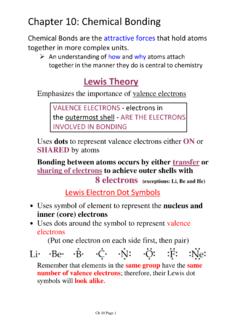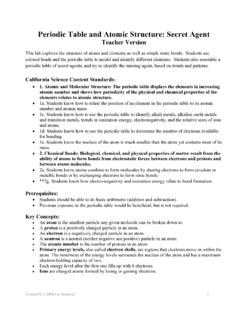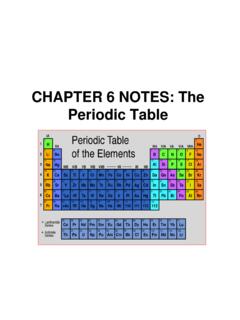Valence Electrons And Ion Formation For
Found 9 free book(s)BONDING AND INTERACTIONS - Friends Meeting School …
fmsbiology.weebly.comValence Electrons Valence electrons are the electrons in the outermost occupied energy level and are involved in ion formation. For a representative element, the group number equals the number of valence electrons the atom contains. An electron dot structure shows the symbol of the element and its valence electrons.
Common Polyatomic Ions - West Virginia University
pltl.wvu.edu♦ Valence Electrons ... An electrostatic attraction between a positive ion and a negative ion, where one or more electrons have been transferred from the valence shell of one atom to the valence shell of ... Formation of Ionic Compounds: ♦ …
CHEMICAL BONDING AND MOLECULAR STRUCTURE - NCERT
ncert.nic.invalence electrons. Kössel, in relation to chemical bonding, drew attention to the following facts: • In the periodic table, the highly electronegative halogens and the highly electropositive alkali metals ar e separated by the noble gases; • The formation of a negative ion from a halogen atom and a positive ion from an alkali metal atom is ...
Chapter 10: Chemical Bonding - Anoka-Ramsey Community …
webs.anokaramsey.eduSubtract electrons used to form covalent bonds from total number of valence electrons in the molecule or ion to determine how many electrons remain (if any). 4. Any remaining electrons become lone pairs, FIRST ON THE OUTSIDE ATOMS to complete their octets, and then on the central atom. 5. If any atoms that need an octet of electrons do not have it,
Writing & Naming Formulas of Ionic ... - Mrs. Jill Perkins
scienceperks.weebly.comThe valence of an elements is the charge an atom takes when it loses or gains electrons and becomes an ion. Metal atoms lose 1, 2 or 3 electrons and become + ions (cations)
La liaison chimique I: la liaison ... - University of Ottawa
mysite.science.uottawa.cavalence qui se font partagés entre deux atomes dans une liaison covalente ... à la formation d’une liaison covalente sont appellés des électrons non-liants ou des doublets ... • dans le cas d’un ion, la somme des charges formelles doit être égale à la charge
Livingston Public Schools / LPS Homepage
www.livingston.orgElements in group IA lose their one valence electron, forming an ion With a 1 + charge. Elements tend to react so that they acquire the electron structure of a halogen. A sodium atom tends to lose one electron when it reacts. The electron structure of a zinc ion (Zn2+) is an example of a pseudo- noble oas formation. A Cl ion is an example of a ...
Periodic Table and Atomic Structure ... - Stanford University
labsci.stanford.eduextra electrons from calcium is transferred to sulfur forming an ionic bond and creating a neutral compound, calcium sulfide. The electrons in the outermost shell can now travel in between the two atoms. The overall charge on CaS is neutral as the positive charge on the calcium ion cancels out the negative charge on the sulfur ion.
CHAPTER 6 NOTES: The Periodic Table - West Linn
www.wlwv.k12.or.usION: an atom or group or atoms that has a positive or negative charge recall…an atom is electrically neutral because it has equal # of protons (+) & # of electrons (-) positive & negative ions form when electrons are transferred between atoms!








